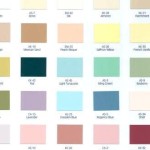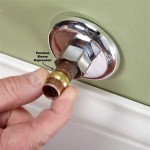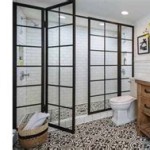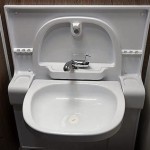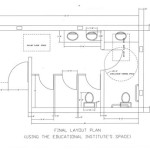Bathroom Vanity Standard Sizes: A Comprehensive Guide
Selecting the right bathroom vanity is a crucial step in any bathroom renovation or new construction project. A vanity serves as both a functional storage solution and a focal point that can significantly impact the overall aesthetic of the space. Understanding standard bathroom vanity sizes is essential for ensuring proper fit, maximizing space utilization, and achieving the desired design outcome. Ignoring these standards can lead to installation difficulties, compromised functionality, and an unbalanced visual appeal.
This article offers a comprehensive guide to bathroom vanity standard sizes, covering various dimensions, configurations, and considerations to assist in making informed decisions during the selection process. We will explore standard heights, depths, and widths of different vanity styles, as well as the factors that influence these sizes. The information presented aims to provide a clear understanding of the options available and how to choose the most suitable vanity for specific bathroom needs.
Standard Bathroom Vanity Heights
The height of a bathroom vanity is a critical dimension that directly affects user comfort and accessibility. The standard height for bathroom vanities has evolved over time, reflecting changing preferences and ergonomic considerations. Traditionally, vanities were typically 30 to 32 inches tall. However, the growing popularity of taller vanities, often referred to as "comfort height" vanities, has reshaped the landscape of bathroom design.
Comfort height vanities generally measure between 34 and 36 inches tall. This increased height offers several advantages, particularly for taller individuals and those with mobility issues. A taller vanity reduces the need to bend over significantly, promoting better posture and reducing strain on the back. For individuals using wheelchairs, a taller vanity can also provide better access and clearance under the sink.
Choosing the right vanity height depends on the specific needs and preferences of the users. Consider the average height of the individuals who will be using the vanity, as well as any mobility limitations. In shared bathrooms, a taller vanity might be a more suitable option to accommodate a wider range of users. It's also important to note that comfort height vanities may require adjusting the height of the mirror and any surrounding fixtures to maintain proper proportions and visual balance in the bathroom.
While comfort height vanities are increasingly popular, standard height vanities remain a viable option, especially in smaller bathrooms or for those who prefer a more traditional aesthetic. Ultimately, the ideal vanity height should prioritize user comfort and accessibility while complementing the overall design of the space.
Standard Bathroom Vanity Depths
The depth of a bathroom vanity refers to the measurement from the front of the vanity to the back, and it significantly impacts the amount of counter space and storage capacity available. Standard vanity depths typically range from 18 to 24 inches. The choice of depth depends on the size of the bathroom, the desired amount of counter space, and the type of sink being used.
A deeper vanity, such as one measuring 21 to 24 inches, provides more counter space for placing toiletries, cosmetics, and other bathroom essentials. It also offers more room for storage underneath the sink, allowing for larger cabinets or drawers. However, a deeper vanity can take up more floor space, which may not be ideal for smaller bathrooms.
A shallower vanity, such as one measuring 18 to 20 inches, is a good option for smaller bathrooms where space is limited. While it offers less counter space and storage, it can still provide sufficient functionality without overwhelming the room. Shallower vanities are also well-suited for powder rooms or guest bathrooms where storage needs are typically less demanding.
When selecting the depth of a bathroom vanity, consider the overall layout of the bathroom and the available space. Ensure that there is enough room to comfortably walk around the vanity and open any doors or drawers without obstructions. It's also important to consider the type of sink being used. Vessel sinks, which sit on top of the countertop, may require a shallower vanity to maintain a comfortable height for use. Undermount sinks, which are installed below the countertop, can work well with vanities of varying depths.
In addition to standard depths, there are also corner vanities available, which are designed to fit into the corner of a bathroom. These vanities typically have a depth of around 16 to 20 inches on each side, and they can be a space-saving solution for smaller bathrooms.
Standard Bathroom Vanity Widths
The width of a bathroom vanity refers to the measurement from one side to the other, and it is the most variable dimension, often dictated by the size of the bathroom and the number of sinks required. Standard vanity widths range from as narrow as 18 inches for small powder rooms to over 72 inches for large master bathrooms with double sinks. The width of the vanity directly impacts the amount of counter space, storage capacity, and the overall visual balance of the bathroom.
Single sink vanities are typically available in widths ranging from 24 to 48 inches. A 24-inch vanity is a common choice for small bathrooms or powder rooms, while a 30 to 36-inch vanity provides more counter space and storage for a single user. A 48-inch vanity offers ample space for both storage and counter space in a single-sink configuration.
Double sink vanities, designed for two users, are typically available in widths ranging from 60 to 72 inches or more. A 60-inch vanity provides a comfortable amount of space for two users, while a 72-inch vanity offers even more room and can accommodate larger sinks or additional storage. When selecting a double sink vanity, ensure that there is enough space between the sinks to allow for comfortable use by two people simultaneously.
Floating vanities, which are mounted to the wall without touching the floor, are available in a variety of widths, similar to standard vanities. These vanities create a sense of spaciousness and can be a good option for smaller bathrooms. However, floating vanities may have limited storage capacity compared to traditional vanities.
When determining the appropriate width of a bathroom vanity, carefully measure the available space in the bathroom and consider the number of users. Ensure that there is enough clearance around the vanity to allow for comfortable movement and access to other fixtures in the bathroom. It's also important to consider the overall design of the bathroom and choose a vanity width that complements the other elements in the space.
Beyond standard widths, custom-built vanities can be designed to fit specific dimensional requirements. Custom vanities allow for complete control over the width, depth, and height of the unit, ensuring a perfect fit for unique bathroom layouts or design preferences. However, custom vanities are typically more expensive than standard vanities and may require a longer lead time for fabrication.
Ultimately, the selection of the bathroom vanity width should be based on a careful assessment of the available space, the number of users, and the desired functionality. By considering these factors, it is possible to choose a vanity that maximizes space utilization, enhances the functionality of the bathroom, and contributes to the overall aesthetic appeal.
In addition to these dimensions, it is also essential to consider the placement of plumbing fixtures when selecting a bathroom vanity. The location of the water supply lines and drainpipe will impact the type of vanity that can be installed and the placement of the sink. Consult with a qualified plumber to ensure that the chosen vanity is compatible with the existing plumbing infrastructure.
It is also important to consider the materials used in the construction of the bathroom vanity. Common materials include wood, MDF (medium-density fiberboard), and plywood. Solid wood vanities are durable and aesthetically pleasing, but they can be more expensive than vanities made from MDF or plywood. MDF vanities are a more affordable option, but they may not be as resistant to moisture as solid wood vanities. Plywood vanities offer a good balance of durability and affordability.
The style of the bathroom vanity should also complement the overall design of the bathroom. Common styles include traditional, contemporary, and transitional. Traditional vanities often feature ornate details and classic designs, while contemporary vanities are characterized by clean lines and minimalist aesthetics. Transitional vanities blend elements of both traditional and contemporary styles, offering a versatile option that can work well in a variety of bathroom designs.
Choosing the right bathroom vanity involves careful consideration of various factors, including height, depth, width, plumbing considerations, materials, and style. By understanding the standard sizes and configurations available, it is possible to select a vanity that meets specific needs and enhances the functionality and aesthetic appeal of the bathroom. Careful planning and attention to detail will ensure a successful bathroom renovation or new construction project.

What S The Standard Depth Of A Bathroom Vanity

What Is The Standard Height Of A Bathroom Vanity

Bathroom Vanity Sizes Dimensions Sink

Dhp Sunnybrooke 30 Inch Bathroom Vanity With Sink Black Com

Pin On Bedroom Furniture

Standard Bathroom Vanity Dimensions With Photos Upgradedhome Com
Bathroom Vanity Sizes In Optimizing Space And Style For Every Wellsons

American Standard Size Sanitary Ware Bathroom Sink White Wash Basin Solid Surface Washing Vanity China Art Made In Com

What Is The Standard Height Of A Bathroom Vanity Sizes Cabinets Vessel Sink

Nano Vanity Unit 80 Cm Shallow Depth
Related Posts
